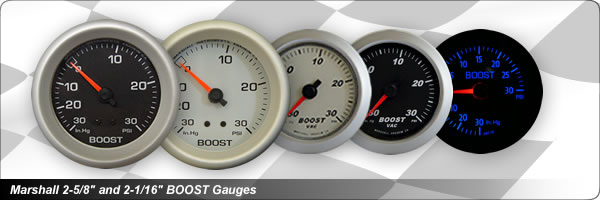Marshall instruments specializes in OEM, private label and custom vacuum and vacuum/boost gauges. Contact us today to discuss your boost pressure gauge requirements.

In Dash Mechanical and Electrical Vacuum/Boost Gauges
Marshall Instruments manufacturers a variety of mechanical and full sweep electric vacuum/boost gauges. Custom dials and private label are our specialty. Please contact us today for a quote.
1-1/2" Direct Mount Boost Gauges
Keep an eye on vacuum pressure with our 1-1/2" vacuum pressure gauges. Available in a variety of pressure ranges and dial styles. Our vacuum gauges are liquid filled to provide vibration resistant readings. The gauges have a center back 1/8" NPT male fitting. U-Clamp mount is available.
Our vacuum pressure gauges are competitively priced and can be provided with custom dials and ranges on request. Custom dials are available. A minimum order of 100 pressure gauges per dial applies for custom dial orders. A one-time set up charge applies for each dial.
Call 800.222.8476 for a quote
Vacuum pressure gauges:
Why Use a Vacuum or Vacuum/Boost Gauge?
Vacuum/Boost gauges are used on non diesel, turbocharged or supercharged vehicles and monitor the boost level. The gauges are used to tune waste gates or for pulley sizing (on supercharged) and monitor the manifold boost level. The vacuum portion of the gauge measures manifold vacuum.
Vacuum/Boost gauges are valuable with nitrous oxide systems to indicate detonation and for indication of leaks, worn parts, and malfunctions. Often used as an engine analyzer and tune-up gauge, the gauge indicates if air is being drawn into the systems from anywhere other than the carburetor which adversely affects the air/fuel mixture.
When used for manifold vacuum, during normal driving the gauge will indicate vacuum. As you accelerate, the vacuum level with decrease. When used to monitor crank case vacuum in nitrous applications a vacuum gauge can be an excellent indicator of detonation. When detonation occurs, vacuum declines.
At Idle:
- After the engine has warmed up a steady reading of 17-21 indicates an engine in good condition.
- Steady below normal readings indicate a constant leak. The lower the reading the larger the leak. A constant leak could be worn piston rings, a leak in the manifold gasket, leaky or worn valve guides, a hole in the manifold or badly seated intake valve.
- An unsteady pointer indicates poor carburetor function, poor plug condition, or faulty ignition.
- An abrupt drop of 3 to 5 points at regular intervals indicates a missing spark plug.
- Erratic drops of 2 to 5 points are an indication of sticky valves, poor carburator function, or ignition troubles.
At Speed:
- Reading will be lower than at idle but the pointer should be steady at any speed.
- An unsteady pointer could indicate bad exhaust valves, a leak in head gasket or faulty ignition.
- At speeds above 40 MPH an unsteady pointer will show weak valve springs, insufficient valve clearance or faulty ignition.
Caution: When in the "Power Range" (5-10) the engine is "lugging" and you should shift into a lower gear.
Caution: When in the "Coasting Range" (21-30) touch the gas occasionally to bring the vacuum reading back into the "Driving Range" (10-17) or shift to a lower gear to prevent the engine from sucking up oil from the crankcase.
Our Customers
We supply customers worldwide. Our customers are in the high performance automotive and motorcyle industry.

About Us ·
Search Catalog ·
FAQs ·
Contact ·
Site Map
· Home




